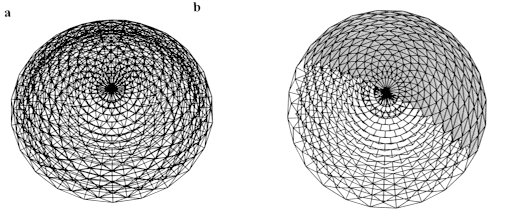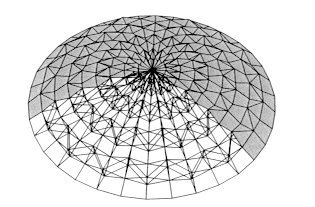|
MODELS BY MEANS OF FORMIAN JANUSZ REBIELAK Name: Janusz Rebielak, Architect, (b. Bierutow, woj. wroclawskie, Poland, 1955). Address: Department of Architecture, Wroclaw University of Technology, ul. B. Prusa 53/55, Wroclaw 50-317, POLAND. E-mail: janusz@novell.arch.pwr.wroc.pl
or j.rebielak@wp.pl
(Currently visiting research fellow at Institute of Industrial Science, University of Tokyo, 4-6-1 Komaba Meguro-Ku, Tokyo 153-8505, JAPAN, E-mail: rebielak@iis.u-tokyo.ac.jp
Fields of interest: Architecture, morphology of space structures as support structures of large span roofs and for high-rise buildings (also - history, aeronautics and space, music, painting, and art - generally). Awards: Award of Rector of the Wroclaw University of Technology, 1982; Award of Rector of the Warsaw University of Technology, 1999; Silver Order of Merit, 1998. Publications: Rebielak, J. (1995) Bar space structures - Rules of shaping, In: Symmetry: Natural and Artificial, Proceedings of the Third Interdisciplinary Symmetry Symposium and Exhibition, Washington, D.C., USA, August 14-20, 1995, Symmetry: Science and Culture, Quarterly of the ISIS-Symmetry, 6, No 3, 442-445. Rebielak, J. (1999) Some proposals of structural systems for long span roofs and high-rise buildings, Journal of the International Association for Shell and Spatial Structures, 40, No 1, 1999, 65-75. Rebielak, J. (2000)
Special forms of structural systems proposed for cable dome, In: Proceedings
of the Third International Conference on Mobile and Rapidly Assembled Structures
–MARAS III, Madrid, June 21-23, 2000, Eds. F. Escrig and C.A. Brebbia,
Southampton, U.K.: Witpress [ISBN: 1-85312-817-1], 93-99.
Abstract: The design
process of complex forms of space structures is mostly difficult. Formian
is the programming language, which makes possible to build numerical models
of any kind of the space structures. These models can be created by means
of numerous parameters and they may be fluently changed without almost
any limits. The mathematical formulations use many times elements of symmetry
and asymmetry. In the paper are presented various propositions of ways
of shaping of structural systems for large span covers, like e.g. for cable
domes. They are shown on examples of these systems, which are invented
and worked out by the author. The pictures presented
in the paper are visualizations of the appropriate digital models, prepared
in Formian for the proposed shapes of the space structure systems.
1 SPACE STRUCTURES AND FORMIAN Structural systems called as space structures are very
often used in the modern architecture and in civil engineering. Space structures,
owing to the specific arrangement of component parts, are characterised
by their own, immanent and logical architectonic views. They have many
advantageous features and that is why they are applied to many useful purposes.
Even the simple form of a space structure is most often a statically indeterminate
structure what causes that the process of its design is usually difficult
and complex. There are many computing programs used in the shaping and
the design of space structures. Formian is the programming language
invented and developed by Hoshyar Nooshin and his team in the Space Structures
Research Centre at the University of Surrey in United Kingdom (Nooshin,
Disney, Yamamoto, 1993). In this programming language the basic principles
of formex algebra are applied, which is also invented by H. Nooshin.
Formian makes possible to build numerical models of the designed
form of any kind of the space structures. These numerical models are bases
for various analyses, which have to be done during the process of the design.
These models can be created by means of numerous parameters and these models
may be fluently changed without almost any limits. The mathematical formulations
may use many times elements of symmetry and asymmetry.
2 EXAMPLES OF SHAPING SPHERICAL
In the paper are presented results of various ways of preparing of digital models for structural systems of large span covers, like e.g. for cable domes. They are shown on examples of these systems, which are invented and developed by the author. The beauty of a structure may be noticed not only in its architectonic view but also during the stage of preparing its numerical model in this programming language (Rebielak, 1999, 2000). In the paper are shown examples of shaping of structural systems, among others, for cable domes developed in the last time by the author. The proposed types of structural systems were obtained as results of suitable transformations of a chosen type of a space structure and the transformations of its component parts. Spherical form of the basic structure is shown in Figure 1a. The picture of that basic structure is a result of an output of the program written in the programming language Formian. Thus it is a visualization of the digital model of that kind of a space structure (Rebielak, 1999, 2000). The cable dome systems are proposed as lightweight structures
for various types of large span roofs. The simple shapes of these systems
consist of concentric hoops, which are built by means of modular elements
having forms mainly of simple kinds of solids. Each type of the structure
is composed of small number of rigid bars and greater number of tensile
members, which are mostly made in form of cables. These systems have to
be pre-stressed in an appropriate way. Domes of large spans, designed by
means of them, may have relatively small rises. Membrane sheets, made of
special type of fabric, could be the component parts of the structural
systems. Roof covers designed by means of the proposed forms of structural
systems can obtain individual and interesting architectural views (Rebielak,
1999, 2000).
Fig.1. a) Spherical shape of a space
structure,
Figure 1b shows the general scheme of the first type of the proposed systems. It was obtained as a result of application and the appropriate transformation of the octahedral modular elements, which are the component parts of the solid system of the structure shown in Fig. 1a. The transformation was done in a few stages. In the first one it was made a differentiation between all of the component parts, which means it was chosen which component is a rigid bar or a cable. Figure 1b shows the cable dome designed in this way with cladding in form of membrane sheets. In this picture the membrane elements are drawn only onto the half area of the entire roof in order to present the arrangement of component parts in space of this type of the proposed structural systems. Figure 2 shows example of another type of structural system proposed by the author for design of cable domes of large spans. In this case the membrane sheets are presented only onto the three fourth area of the entire cladding surface. In the patterns of the presented space structures one can easily observe many types of symmetries. The keeping of a suitable symmetry is necessary in order to provide these structures with the appropriate stability and rigidity (Rebielak, 1995).
3 CLOSING REMARKS The digital models of these systems can be prepared in the programming language Formian in many ways. Very complex shapes of structural systems may be defined in this language by usage of very short form of description what is possible owing to application the basic rules of the symmetry. Even asymmetrical forms of some space structures can be easily and simply defined in Formian by suitable applying of symmetrical formulations. In the way of shaping of space structure by means of Formian one can notice the very clear and the good examples of the intersections of art and science and/or the symmetry or asymmetry involved between them and inside each of them.
Fig.2. General view of the second type of the proposed systems for cable domes
References Nooshin, H., Disney, P., and Yamamoto, C. (1993) Formian, U.K.: Multi-Science Publishers. Rebielak, J. (1995) Bar space structures - Rules of shaping, In: Symmetry: Natural and Artificial, Proceedings of the Third Interdisciplinary Symmetry Symposium and Exhibition, Washington, D.C., U.S.A., August 14-20, 1995, Symmetry: Science and Culture, Quarterly of the ISIS-Symmetry, 6, No 3, 442-445. Rebielak, J. (1999) Some proposals of structural systems for long span roofs and high-rise buildings, Journal of the International Association for Shell and Spatial Structures, 40, No 1, 1999, 65-75. Rebielak, J. (1999) Cable dome shaped on the ground of the {T – T} double-layer space structure: Example of Formian’s application in creation of numerical model of a structure, Lightweight Structures in Civil Engineering, Warsaw, Poland: Micro-Publisher Jan B. Obrebski Wydawnictwo Naukowe, 86-87 Rebielak, J. (2000) Special forms of structural systems proposed for cable dome, In: Proceedings of the Third International Conference on Mobile and Rapidly Assembled Structures –MARAS III, Madrid, June 21-23, 2000, Eds. F. Escrig and C.A. Brebbia, Southampton, U.K.: Witpress [ISBN: 1-85312-817-1], 93-99. Rebielak, J. (2000) Ksztaltowanie systemów konstrukcyjnych kopul pretowo-ciegnowych, [in Polish], Architektura-murator, 12, 90-92. Rebielak, J. (2000) Structural system
of cable dome shaped by means of simple form of spatial hoops, Lightweight
Structures in Civil Engineering, Warsaw, Poland: Micro-Publisher Jan
B. Obrebski Wydawnictwo Naukowe, 114-115.
|

